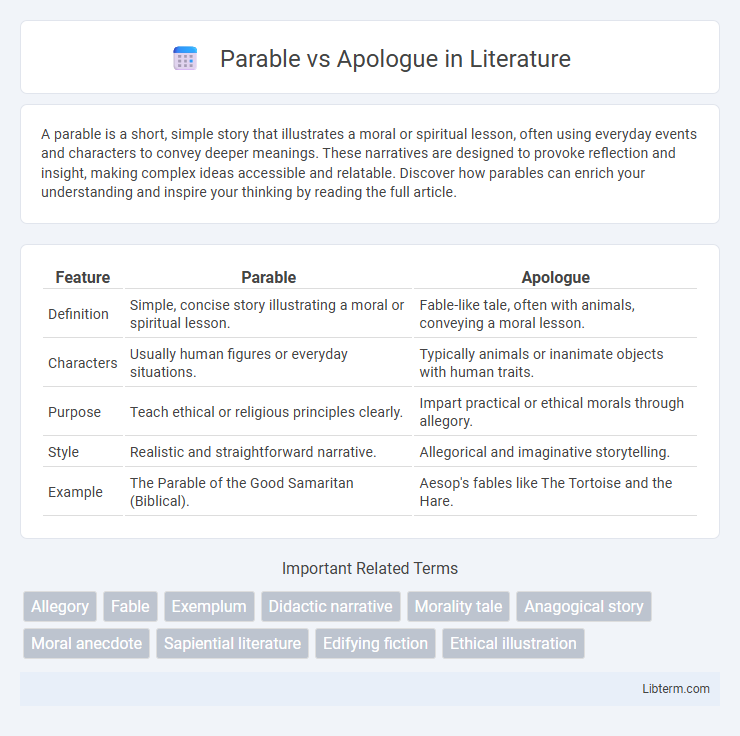A parable is a short, simple story that illustrates a moral or spiritual lesson, often using everyday events and characters to convey deeper meanings. These narratives are designed to provoke reflection and insight, making complex ideas accessible and relatable. Discover how parables can enrich your understanding and inspire your thinking by reading the full article.
Table of Comparison
| Feature | Parable | Apologue |
|---|---|---|
| Definition | Simple, concise story illustrating a moral or spiritual lesson. | Fable-like tale, often with animals, conveying a moral lesson. |
| Characters | Usually human figures or everyday situations. | Typically animals or inanimate objects with human traits. |
| Purpose | Teach ethical or religious principles clearly. | Impart practical or ethical morals through allegory. |
| Style | Realistic and straightforward narrative. | Allegorical and imaginative storytelling. |
| Example | The Parable of the Good Samaritan (Biblical). | Aesop's fables like The Tortoise and the Hare. |
Understanding Parables: A Definition
Parables are succinct narratives designed to convey moral or spiritual lessons through relatable scenarios, often featuring human characters and realistic settings. Unlike apologues, which explicitly use animals or inanimate objects as characters to illustrate a point, parables emphasize human behavior and ethical dilemmas to provoke reflection and insight. This storytelling method has been widely used in religious texts, such as the Bible, to facilitate comprehension of complex doctrines by linking them to everyday experiences.
What is an Apologue?
An apologue is a short allegorical narrative designed to convey a moral lesson through personified characters or animals, often using symbolism and metaphor. It functions as a didactic tool that emphasizes ethical principles by illustrating consequences of behavior in a simplified, memorable format. Unlike a parable, which typically uses human characters and realistic situations, an apologue relies heavily on fable-like elements to engage readers and reinforce its teaching.
Key Characteristics of Parables
Parables are succinct, allegorical stories that illustrate moral or spiritual lessons through everyday scenarios, often performed by Jesus in the Bible to convey profound truths to diverse audiences. They typically feature human characters and realistic settings, making abstract concepts accessible and memorable by engaging the listener's imagination. The key characteristics of parables include simplicity in narrative, use of metaphor, and an underlying message that requires interpretation, distinguishing them from apologues which tend to involve animals or inanimate objects as characters.
Distinct Features of Apologues
Apologues are short moral stories that use animals, plants, or inanimate objects as characters to convey ethical lessons, emphasizing direct and clear moral instruction. Unlike parables, which typically feature human characters and rely on metaphorical or spiritual meanings, apologues are characterized by their simplicity and explicit didactic purpose. This distinct feature makes apologues effective tools in teaching practical wisdom and social values across various cultures.
Historical Origins of Parables and Apologues
Parables and apologues both originated in ancient storytelling traditions, serving as didactic tools to convey moral or spiritual lessons through allegory and analogy. Parables, prominently featured in religious texts such as the Bible, trace back to Jewish and early Christian oral traditions that used simple, relatable narratives to illustrate ethical principles. Apologues, often found in Aesop's Fables from ancient Greece, emerged as concise, fictional tales featuring animals or inanimate objects to teach practical wisdom and social values.
Purposes and Functions in Literature
Parables serve primarily to convey moral or spiritual lessons through simple, relatable stories, often with allegorical meanings that prompt reflection and ethical understanding. Apologues, while similar, typically emphasize practical wisdom or cautionary advice by using animals or inanimate objects as characters to illustrate human follies or societal norms. Both forms function to instruct and influence behavior, but parables lean towards religious or philosophical teachings whereas apologues focus on pragmatic lessons.
Moral Lessons: Parable vs Apologue
Parables convey moral lessons through simple, human-centered stories that illustrate spiritual or ethical truths, often found in religious texts and sermons. Apologues use allegorical narratives featuring animals, plants, or inanimate objects to teach practical wisdom or ethical behavior, typically emphasizing clear moral conclusions. While parables invite reflection on deeper meanings, apologues deliver direct, concise moral lessons through symbolic characters.
Notable Examples of Parables
Notable examples of parables include the Parable of the Good Samaritan, which teaches compassion and neighborly love, and the Parable of the Prodigal Son, illustrating forgiveness and redemption. These stories, primarily found in the New Testament of the Bible, use simple narratives with moral or spiritual lessons to convey profound truths. Unlike apologues, which often feature animals as characters, parables typically involve human figures and real-life situations to emphasize ethical teachings.
Famous Apologues in Literature
Famous apologues in literature, such as Aesop's fables including "The Tortoise and the Hare" and "The Fox and the Grapes," use animals and fictional characters to convey moral lessons through allegory. Unlike parables, which often involve human characters and direct spiritual or ethical teachings, apologues emphasize storytelling with anthropomorphized figures to illustrate practical wisdom. The enduring popularity of apologues lies in their ability to engage readers with memorable narratives that highlight virtues like patience, honesty, and humility.
Choosing Between Parable and Apologue
Choosing between a parable and an apologue depends on the narrative style and audience engagement desired; parables use simple, realistic stories often with human characters to convey moral or spiritual lessons. Apologues typically feature animals or inanimate objects personified to illustrate ethical principles indirectly. Understanding the context of the message and the preferred level of abstraction guides effective selection for communication impact.
Parable Infographic

 libterm.com
libterm.com